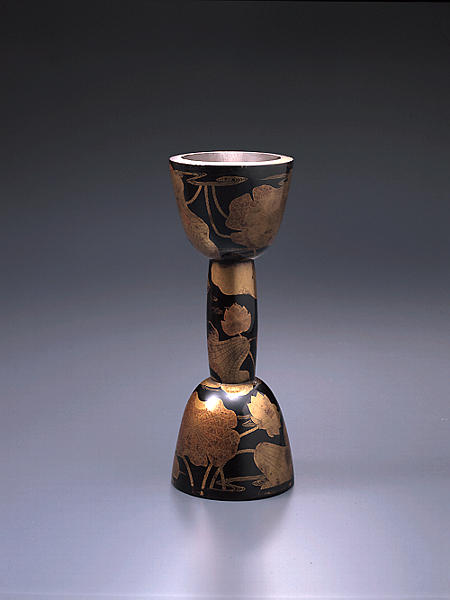蓮池蒔絵小鼓胴
- 安土桃山時代
- 16世紀
- 木製漆塗蒔絵
- H-25.4 D-10
- 所蔵
- MIHO MUSEUM
胴全体に蓮池を蒔絵した小鼓の胴である。流水に蓮の花、葉、茎を意匠するが、生き生きとした動きが感じられる。高台寺蒔絵の技法で、金平蒔絵、絵梨地、付描、描割、針描を細部に用いている。葉に描かれた虫喰表現は高台寺蒔絵独特のものである。蓮池文様というと平安・鎌倉時代の仏具の意匠が主であるが、この近世の楽器の意匠には宗教色を感じさせない明るさがある。
桃山時代 16世紀
高:25.4cm 口径:10.0cm
小鼓の胴,総体黒漆塗。胴全体に蓮池を蒔絵している。流水に蓮の花・葉・茎を意匠するが生き生きとした動きが感じられる。技法は高台寺蒔絵,金平蒔絵に絵梨地・付描・描割・針描を細部に用いている。また,葉に描かれた虫喰いの表現は高台寺蒔絵独特のもの。
蓮池文様というと平安・鎌倉時代の仏具の意匠が主であるが,この近世の楽器の意匠は宗教色を感じさせることなく明るい。 (灰野)
Catalogue Entry
Momoyama period, 16th century
Height, 25.4cm; mouth diameter, 10.0cm
Drum cylinder for a small drum. Coated overall in black lacquer. A lotus pond pattern in makie spreads across the entire surface. Rippling water, lotus flowers, leaves, and stems are depicted with a lively sense of movement. This work includes the Kodaiji makie techniques of gold hiramakie with enashiji patterning and the detailed use of tsuke-gaki, kaki-wari, and hari-gaki lacquer drawing techniques. The traces of worm-holes drawn on the leaves are unique to the Kodaiji makie style.
While the lotus pond motif was mainly used on Buddhist implements during the Heian and Kamakura periods, its use on this pre-modern era musical instrument avoids a specifically religious feeling. AH
